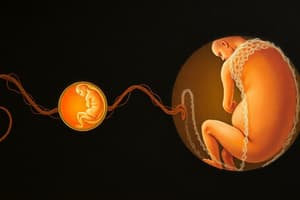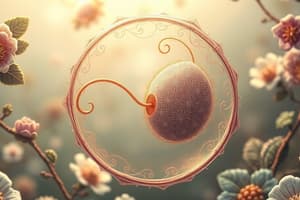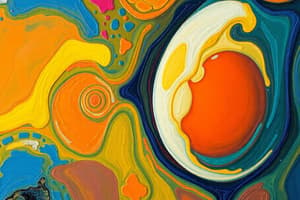Podcast
Questions and Answers
What is the primary role of the placenta during pregnancy?
What is the primary role of the placenta during pregnancy?
- Facilitating the exchange of oxygen and nutrients between the mother and the developing fetus. (correct)
- Protecting the embryo from external shocks with a fluid-filled sac.
- Filtering waste products from the mother's blood to protect the developing fetus.
- Producing hormones to maintain the uterine lining throughout gestation.
What is the typical duration of the menstrual cycle, and what occurs if the egg is not fertilized?
What is the typical duration of the menstrual cycle, and what occurs if the egg is not fertilized?
- Approximately 35 days; the egg travels back to the ovary to be reused in the next cycle.
- Approximately 21 days; the egg is reabsorbed by the oviduct.
- Approximately 28 days; the uterine lining sheds, resulting in menstruation. (correct)
- Approximately 28 days; the egg disintegrates within the ovary.
Which of the following correctly orders the structures involved in the early stages of pregnancy, beginning with fertilization?
Which of the following correctly orders the structures involved in the early stages of pregnancy, beginning with fertilization?
- Sperm → Egg → Uterus → Embryo
- Sperm → Egg → Embryo → Umbilical Cord
- Egg → Sperm → Embryo → Uterus
- Sperm → Egg → Embryo → Placenta (correct)
What is the role of the amniotic fluid during pregnancy, and what could be a potential risk if there is insufficient amniotic fluid?
What is the role of the amniotic fluid during pregnancy, and what could be a potential risk if there is insufficient amniotic fluid?
How do the placenta and umbilical cord function together to support fetal development?
How do the placenta and umbilical cord function together to support fetal development?
Flashcards
Fertilization
Fertilization
The process where sperm and egg combine to form an embryo.
Menstrual Cycle
Menstrual Cycle
A monthly cycle lasting about 28 days, involving egg production and shedding of the uterine lining if not fertilized.
Amniotic Fluid
Amniotic Fluid
A fluid that surrounds and protects the embryo during pregnancy.
Placenta
Placenta
Signup and view all the flashcards
Umbilical Cord
Umbilical Cord
Signup and view all the flashcards
Study Notes
Fertilization and Embryo Development
- Fertilization occurs when a sperm cell from a male and an egg cell from a female combine.
- This creates a zygote (embryo).
- The female reproductive organs (ovaries) produce eggs.
- The male reproductive organs (testes) produce sperm.
- The menstrual cycle is approximately 28 days long.
- The egg is released from the ovary during ovulation.
- If fertilization happens, the egg travels to the uterus.
- The fertilized egg will embed in the uterine wall.
- Within 9 months, the embryo will develop into a fetus.
Embryo Development
- The embryo develops in the uterus.
- The embryo is an early stage of fetal development.
- The menstrual cycle can last around 28 days.
- The egg is fertilised and descends through the oviduct to the uterus.
- The uterus is prepared for possible implantation and for the eventual pregnancy.
Pregnancy
- Pregnancy lasts for around 9 months.
- The placenta is an organ that develops in the uterus to provide nutrients and oxygen to the embryo/fetus.
- Amniotic fluid surrounds the embryo for protection.
- The developing embryo/fetus and the mother are connected by the umbilical cord.
- The umbilical cord carries nutrients and oxygen from the mother to the embryo/fetus and removes waste products.
Placenta
- The placenta provides nutrients and oxygen to the growing embryo/fetus.
- The umbilical cord connects the placenta to the embryo.
Studying That Suits You
Use AI to generate personalized quizzes and flashcards to suit your learning preferences.





